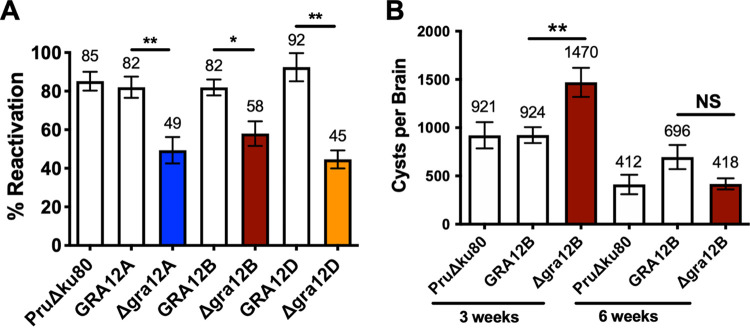FIG 6.
GRA12-related gene knockout mutants exhibit reduced cyst maintenance and cyst reactivation. (A) Reactivation assays were performed using in vitro cysts differentiated for 3 days after HFF cell cultures were infected with 2 × 102 tachyzoites of parental PruΔku80, Δgra12A::GRA12A or Δgra12A, Δgra12B::GRA12B or Δgra12B, and Δgra12D::GRA12D or Δgra12D. Percent reactivation (mean ± SEM) from three independent experiments is shown. A one-way ANOVA test revealed significance in reactivation [F(6, 20) = 8.642, P = 0.0001], and a Tukey test was used to calculate P values in comparison to parental control PruΔku80 and the respective complemented strain as follows: *, P < 0.05; **, P < 0.01. (B) C57BL/6 female mice (n = 6 to 13) were infected i.p. with 2 × 102 tachyzoites of PruΔku80, Δgra12B, or Δgra12B::GRA12B strain, and brain cyst burdens were measured 3 and 6 weeks postinfection (mean ± SEM). Data shown are cumulative results from two to four independent experiments for each strain. At 3 weeks, PruΔku80 (two experiments, n = 8), Δgra12B (two experiments, n = 8), and GRA12B (four experiments, n = 13) strains are shown. At 6 weeks, PruΔku80 (two experiments, n = 6), Δgra12B (two experiments, n = 6), and GRA12B (three experiments, n = 10) strains are shown. A one-way ANOVA test revealed significance in reactivation [F(5, 45) = 9.909, P < 0.0001], and a Tukey test was used to calculate P values in comparison to parental control PruΔku80 and the respective complemented strain as follows: **, P < 0.01; NS, not significant.

